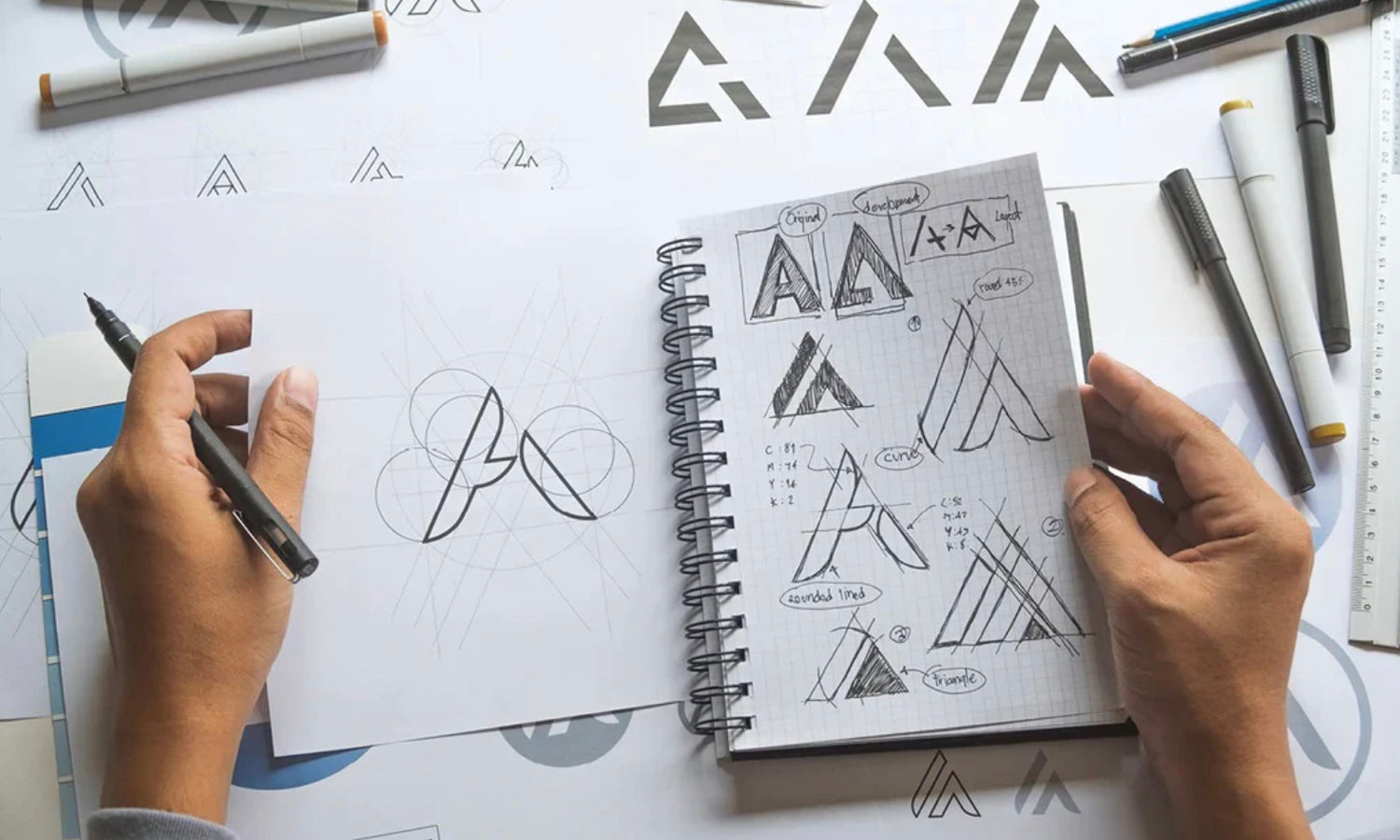The Evolution of Logo Design in Marketing Industry

Source: Ahmed, Evolve Brand Visual Identity, Dribbble, https://dribbble.com/shots/19476779-Evolve-Brand-Visual-Identity
Logo design has always been a visual cornerstone in the marketing industry, shaping how brands present themselves to the world. From ancient symbols carved into stone to sleek, scalable icons on digital platforms, the evolution of logos mirrors the transformation of marketing practices. As businesses grew more competitive and markets became increasingly saturated, a distinctive logo became not just a creative asset but a strategic necessity.
In the early days, logos were straightforward—often literal illustrations of a product or service. Over time, the marketing industry began to embrace more abstract and conceptual design elements to better capture emotion, trust, and uniqueness. Typography, color theory, and layout techniques have been refined through each era to enhance recognition and storytelling.
With the emergence of mass media and the digital age, logo design adapted quickly to remain effective across various formats—from billboards and packaging to mobile screens and social media avatars. Today, a logo’s impact depends on its flexibility, simplicity, and emotional resonance. Understanding how logo design has evolved within the marketing industry offers valuable insight into branding’s dynamic role in business communication. This evolution continues as technology and consumer expectations push the boundaries of visual identity.
Early Logos Were Literal Representations
In the earliest phases of logo design, simplicity was not just a stylistic choice—it was a necessity. Before advanced printing technologies or mass communication, logos functioned as straightforward identifiers. Artisans, merchants, and small businesses in pre-industrial societies often used hand-drawn emblems that visually represented the core of what they sold or provided. A blacksmith, for example, might use an anvil symbol, while a bakery could feature wheat or a loaf of bread.
These literal representations served a practical function: they conveyed information quickly in a largely illiterate society. In this context, logo design had to communicate without words. Visual metaphors were direct and universally understood, rooted in everyday experiences and shared symbols.
Within the early marketing industry, even as formal branding was not yet a defined concept, the power of recognizable imagery became apparent. These early logos appeared on storefront signs, printed pamphlets, and product containers—each acting as a point of contact between business and customer.
Though basic in form, these literal logos laid the groundwork for the complex brand identities seen today. They demonstrated how logo design could serve as a powerful marketing tool long before advertising agencies and brand strategists existed. The focus was clarity, and effectiveness was measured by how well a symbol matched its trade.
Industrial Revolution Brought Standardization
The Industrial Revolution marked a turning point in the history of logo design, particularly as it intersected with the growing needs of the marketing industry. Mass production and expanded distribution channels demanded a more structured and repeatable approach to branding. As goods were manufactured at scale, businesses needed logos that could be reproduced consistently across packaging, signage, and advertising materials.
This era introduced new printing technologies, such as lithography and mechanized presses, which influenced how logos were designed. Clean lines, bold shapes, and legible typography became essential characteristics. Logos shifted from ornate and hand-drawn styles to more standardized, geometric forms that could be easily replicated without losing detail or clarity.
In the marketing industry, the need for consistency became paramount. A logo needed to look the same on every crate, invoice, or advertisement. As a result, companies began to invest in professional logo design, treating it as a fundamental part of their marketing toolkit. Graphic designers emerged as key players in crafting identities that would represent products and services far beyond the local community.
Typography Became A Defining Element
As logo design continued to evolve alongside the marketing industry, typography emerged as a crucial element in shaping brand identity. During the early to mid-20th century, the shift toward type-based logos reflected a broader desire for clarity, professionalism, and memorability. Businesses began to move away from solely pictorial logos and started incorporating custom lettering or distinctive fonts that would make their names stand out in crowded markets.
Typography allowed for a deeper level of brand differentiation. Serif fonts communicated tradition and reliability, while sans-serif styles suggested modernity and efficiency. The marketing industry recognized the power of typography not just to spell out a company’s name, but to evoke a specific tone, emotion, or cultural association.
Brands like Coca-Cola and IBM capitalized on this movement by using strong, recognizable typefaces as the foundation of their logos. Their success demonstrated how typography could become a visual asset as memorable as any graphic symbol.
Moreover, advancements in typesetting and printing made it easier for designers to experiment with letterforms. Typography became a playground for creativity while maintaining function. From bold and geometric to elegant and script-based, type-driven logo design transformed the way companies presented themselves across advertisements, packaging, and signage—reinforcing the importance of readability and style in brand communication.

Source: Dusan Sol, Tinley Tea, Dribbble, https://dribbble.com/shots/23282706-Tinley-Tea
Color Usage Started To Define Identity
In the progression of logo design within the marketing industry, the strategic use of color became a defining component of brand identity. As printing techniques improved and consumer psychology became more studied, marketers and designers began to understand the emotional and associative power of color.
Color transitioned from being purely decorative to a purposeful design tool. Red began to be associated with energy and urgency, making it popular in fast-food logos. Blue, known for its calming and trustworthy qualities, found favor with banks and tech companies. Yellow evoked optimism, while green symbolized freshness or environmental values. These associations helped brands connect more effectively with their target audiences.
The marketing industry leveraged color to improve recognition and recall. A well-chosen palette could ensure that a logo stood out on shelves, in advertisements, and across competitive visual landscapes. More importantly, consistent color usage across all touchpoints built familiarity and reinforced the brand’s message over time.
Designers began developing logos with color psychology in mind, selecting hues that aligned with a company’s values, tone, and intended perception. This shift marked a significant advancement in how logo design operated—not just as a visual mark, but as a strategic communicator.
Color became more than aesthetic; it became identity. Its thoughtful integration into logo design ensured that a brand’s personality could be instantly conveyed—even before a single word was read.
Symbolism Took Center Stage
As logo design matured within the marketing industry, a pivotal shift occurred—symbolism began to replace literal imagery. Rather than directly illustrating a product or service, logos evolved to convey broader meanings, emotions, and ideas through abstract or metaphorical visuals. This transition allowed brands to build deeper, more flexible identities that transcended specific offerings.
Symbolism enabled logo design to move into a space of interpretation. A simple apple could represent knowledge, a swoosh could imply speed and momentum, and an arrow hidden within a wordmark could suggest direction or precision. These symbolic visuals sparked curiosity and invited audiences to form emotional connections with brands.
This phase of evolution aligned with the growing complexity of the marketing industry. As companies expanded globally, logos had to be universally recognizable without relying on language or cultural specificity. Symbols offered a powerful visual shorthand—instantly memorable, easily scalable, and capable of standing alone without text.
Designers carefully crafted icons that captured brand values while maintaining simplicity. Through shapes, negative space, and visual metaphors, symbolism became a key storytelling device in logo design. It gave companies the freedom to evolve their message while retaining a consistent visual identity, reinforcing their presence in increasingly competitive markets.
Post-War Modernism Influenced Clean Aesthetics
The aftermath of World War II brought a modernist wave that profoundly impacted logo design in the marketing industry. Inspired by Bauhaus principles and the International Typographic Style, designers embraced minimalism, grid systems, and geometric order. The goal was to communicate more with less—stripping away ornamentation to reveal essential form and function.
In this modernist era, logos became cleaner, more structured, and easier to reproduce across various media. Design shifted from expressive flourishes to rational clarity, aligning with the growing need for consistency in large-scale corporate branding. The marketing industry quickly adopted this new aesthetic, recognizing its ability to enhance legibility and strengthen brand presence.
Companies like IBM, ABC, and Lufthansa became early adopters of modernist principles. Their logos were composed of strong typography, balanced spacing, and simple shapes—design elements that could stand the test of time. These identities reflected a sense of professionalism and reliability, which resonated with consumers during a period of global rebuilding and economic growth.
This design philosophy prioritized clarity over decoration, leading to logos that were adaptable and highly recognizable. The marketing industry found in modernism a disciplined visual language that communicated efficiency, innovation, and trust—values essential to brands seeking long-term loyalty. Modernist logo design set new standards for visual communication and continues to influence brand identities today.
Hand-Drawn Logos Gained Popularity
In response to the growing dominance of digital precision and corporate minimalism, hand-drawn logos began gaining popularity as a counter-movement within the logo design world. Particularly in the marketing industry, brands started seeking ways to appear more personal, approachable, and human. Hand-drawn logos provided the perfect solution—infusing individuality, warmth, and storytelling into a brand’s visual identity.
This style became especially appealing to small businesses, artisanal brands, and creative industries that wanted to showcase authenticity. A hand-drawn logo signaled craftsmanship, uniqueness, and a break from the sterile, mass-produced look. It reflected values like originality and sincerity, which resonated with audiences tired of generic brand visuals.
Designers took inspiration from vintage signage, calligraphy, sketching, and custom lettering to build logos that felt one-of-a-kind. The imperfections in these designs—wavy lines, textured strokes, or irregular spacing—added character and charm. This visual language allowed brands to differentiate themselves in highly saturated markets where personality could be a competitive edge.

Source: Kiran, Bull Sketch, Dribbble, https://dribbble.com/shots/6223061-Bull-Sketch
Digital Era Introduced Scalable Design
The arrival of the digital era transformed logo design in the marketing industry, introducing the need for scalability across multiple devices, platforms, and screen sizes. With brands expanding their presence into websites, mobile apps, and social media, a logo had to function seamlessly in both large and compact formats.
This shift led designers to embrace vector graphics and responsive logo systems. A single logo design would now have to adapt—from desktop banners to tiny app icons—without losing its clarity or impact. Complex details, ornate effects, and elaborate textures became less practical, pushing logo design toward minimalism and cleaner forms.
Scalability also demanded precision in line work, spacing, and proportions. A well-executed logo in the digital age had to retain its identity whether viewed in high resolution on a large monitor or as a favicon in a browser tab. The marketing industry recognized this need and started prioritizing design consistency across every digital touchpoint.
As branding extended into motion graphics and interactive content, logos needed to be versatile enough to animate or transform without breaking recognition. This new digital standard redefined what made a logo effective—not just visual appeal, but functionality across all digital contexts.
Flat Design Became The New Norm
Flat design marked a significant shift in logo design, especially as the marketing industry became more digitally driven. Emerging in the early 2010s, flat design rejected complex textures, gradients, and three-dimensional effects in favor of clean, two-dimensional elements. This style was not only visually appealing but also aligned with the functional needs of digital platforms.
Flat logos were easier to render across different screen sizes and resolutions. They loaded faster, appeared crisp on retina displays, and maintained clarity even when scaled down. These advantages made flat design an industry standard as mobile usage skyrocketed and user interface design prioritized simplicity and efficiency.
In the marketing industry, flat logos helped brands project a modern, tech-savvy image. The minimalist aesthetic communicated professionalism and clarity, cutting through visual clutter. Major corporations like Google, Microsoft, and Mastercard adopted flat logos to streamline their identities and improve digital performance.
This movement also democratized logo design, influencing startups and small businesses to embrace minimalism as a way to compete visually with larger brands. The removal of shadows, embossing, and decorative layers brought logo design back to its essentials—form, color, and concept.
Dynamic Logos Offered Flexibility
As branding expanded beyond static platforms, dynamic logos emerged as a response to the evolving demands of the marketing industry. Unlike traditional fixed marks, dynamic logos are designed to adapt—changing in color, shape, orientation, or complexity—while retaining core identity elements. This approach gave brands newfound flexibility in how they communicated across diverse media.
In an era dominated by digital interaction, motion graphics, and personalized content, dynamic logo design allowed companies to remain relevant and responsive. A brand could present one version of its logo on a mobile app, another for social campaigns, and a different variation for seasonal promotions—all without losing recognition.
The marketing industry quickly recognized the value of this versatility. Dynamic logos supported storytelling, engagement, and differentiation in crowded markets. They became tools for building immersive brand experiences that aligned with various touchpoints—whether animated intros, merchandise, or event signage.
Designers often used modular systems or responsive design grids to ensure cohesion across logo variations. While the look could change, the fundamental structure—such as a signature color, shape, or letterform—remained constant.
This evolution in logo design reflects a larger shift toward adaptability and customization in branding. In a world where brands must be agile and audience-focused, dynamic logos serve as a visual solution that evolves with context—without compromising identity.
Conclusion
The evolution of logo design within the marketing industry reflects more than just changing aesthetics—it captures the shifts in technology, consumer behavior, and brand communication strategies. From literal illustrations to scalable, dynamic visuals, each stage of development has enhanced how businesses connect with audiences. As the marketing industry grows more complex and multi-platform, logo design continues to adapt—balancing creativity with clarity, flexibility with consistency. Understanding this progression not only deepens appreciation for design but also highlights its critical role in building lasting brand identities. The journey of logo design is far from over, as innovation continues to shape its future.
Let Us Know What You Think!
Every information you read here are written and curated by Kreafolk's team, carefully pieced together with our creative community in mind. Did you enjoy our contents? Leave a comment below and share your thoughts. Cheers to more creative articles and inspirations!
















Leave a Comment